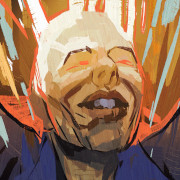|
Easier to read than to reed.
|
|
|
|

|
| # ? May 25, 2024 18:29 |
|
Nessus posted:This came up in another context, but what evidence is there for early mathematics, especially in cultures just now getting literacy? Evidence of counting predates writing by about 35K years... https://en.m.wikipedia.org/wiki/Ishango_bone
|
|
|
|
Nessus posted:This came up in another context, but what evidence is there for early mathematics, especially in cultures just now getting literacy? In terms of the places where literacy began, namely Mesopotamia/SW Iran and Egypt, use of numbers (and possibly mathematics) predates the invention of writing, and went hand in hand with the invention of writing. Before any form of writing was used, Mesopotamians recorded numbers by placing clay balls in a sealed container (which, being sealed, could be consulted later to verify the number that was being recorded). The earliest written documents in the world are accounting documents from Mesopotamia that lack a fully fleshed system for recording language, and these accounting documents probably have their roots in earlier forms of non-written accounting systems, such as the sealed containers of clay balls. Written mathematics actually predates the writing of conjugated verbs by quite a few centuries. These documents could record large numbers, and mathematical operations done with large numbers, quite precisely. Numbers in the tens of thousands are attested in these very early accounting tablets. But during this early period of writing, there was no way to record a letter or a work of literature. So you don't need to have a sophisticated system of literacy to record numbers and math. There are a lot of other examples like this from other cultures, such as various counting and mental math systems that use combinations of finger and hand positions as a memory/calculation aid. Also picking nine as the highest number you can count to without writing is very rooted in the modern base ten system. There's nothing special about ten, except for the fact that we use a base ten system to count in, which makes it seem special to us. So in a non-literate society that has not been exposed to a base ten numerical system, there's no reason for nine to be the breakpoint between countable quantities and uncountable quantities.
|
|
|
|
Ten is special because humans have ten fingers, if nothing else.
|
|
|
|
That kind of thinking can lead you astray real fast. Humans have ten fingers, twenty digits, 14 countable phalanges in each hand.
|
|
|
|
Gaius Marius posted:That kind of thinking can lead you astray real fast. Humans have ten fingers, twenty digits, 14 countable phalanges in each hand. has there been any evidence to substantiate the idea that base-12 counting came from folks counting their non-thumb phalanges on one hand? i always liked that theory.
|
|
|
|
wouldn't surprise me if there's a connection to there being (roughly) 12 lunar cycles per year, though idk how you'd go about proving that
|
|
|
|
This stuff is so ancient I don't think it's provable in any way, but I also don't think it's coincidental there are a bunch of counting systems with bases that directly correspond to various ways of counting with your fingers.
|
|
|
|
Sleng Teng posted:To be quite honest that’s part of why some of these disputes are very funny (when you aren’t involved, at a distance) And why they are extremely comparable to styles of internet argument we know all too well. Grand Fromage posted:This stuff is so ancient I don't think it's provable in any way, but I also don't think it's coincidental there are a bunch of counting systems with bases that directly correspond to various ways of counting with your fingers. Yep, same tools, different ways. I imagine it was just a matter of what caught on first. I remember how I was taught to remember which months have 30 or 31 days by counting my knuckles and the gaps between them.
|
|
|
|
there's no proof of it that I've ever heard but the 12s system counting the knucklebones with the thumb (and using the second hand to take it to 60) is really convincing to me just because of how loving useful 12 and 60 are. They make 10 look like a pile of puke tbh. If those idiots in france had gotten their poo poo together and just changed the number system to base 12 instead of "Rationalizing" it all to base 10 they'd probably still be in power
|
|
|
|
CommonShore posted:there's no proof of it that I've ever heard but the 12s system counting the knucklebones with the thumb (and using the second hand to take it to 60) is really convincing to me just because of how loving useful 12 and 60 are. They make 10 look like a pile of puke tbh. I'm pretty sure base 60 came about because of its usefulness for computing fractions rather than anything to do with knuckle bones. It also used 10 as a sub-base for the notation, so I doubt it originated in base 12. (IIRC the base 12 system developed in Central America?)
|
|
|
|
my preferred base is 6; it has most of the same properties as base 12, but more divisions result in easy-to-remember numbers
|
|
|
|
Five would just be another seven if it weren't for our meat flaps.
|
|
|
|
FreudianSlippers posted:I can sometimes kinda sorta puzzle the meaning out of Old English texts as an Icelandic speaker. According to Gunnlaugur Serpenttongue's saga (written in the 1200s, set right around year 1000) Gunnlaugur is an itinerant poet from Iceland, goes to England, and is able to have his poetry understood because the language was the same. I probably wouldn't take "the same" literally, but just to mean that it's mutually intelligible. Note that this takes place well post-Danelaw, so I don't know if a Viking at Lindisfarne in 793 could make himself understood to people at that time.
|
|
|
|
Lead out in cuffs posted:I'm pretty sure base 60 came about because of its usefulness for computing fractions rather than anything to do with knuckle bones. Base 60 has been around for over 5k years, though. I’m sure it’s not because they decided it was easier to use with fractions and was because it was just how they naturally counted. Another anachronistic type of counting is the nautical point. So easy to just say “contact at 2 points off the starboard bow” than it is to read out degrees.
|
|
|
|
For some reason I thought the 60 minute hour and twenty four hour day derived from the babylonians, and were due to the ease of division.
|
|
|
|
|
Hieronymous Alloy posted:For some reason I thought the 60 minute hour and twenty four hour day derived from the babylonians, and were due to the ease of division. This is all true. Base 60 and Base 12 systems were invented by the Sumerians and Babylonians and used expressly because of their factorability.
|
|
|
|
I thought it was that different cultures did a mix of base-10 (because fingers) and base 12 (because division) and we even have a vestige of that in English with "eleven" and "twelve" rather than "oneteen" and "twoteen". The finger bones thing always sounded like a just-so story to me.
|
|
|
|
Do we know why they used it ? Or just that they did
|
|
|
|
Omnomnomnivore posted:I thought it was that different cultures did a mix of base-10 (because fingers) and base 12 (because division) and we even have a vestige of that in English with "eleven" and "twelve" rather than "oneteen" and "twoteen". The finger bones thing always sounded like a just-so story to me. Yup. For example, the Sumerian system used 10 characters to demarcate numbers (1-9 and then a < to indicate 10) and counted things in units of 12. They used sign-value notation, so fifteen would be either 5< or <5. If you needed a number beyond the format, you added an additional segment. The Babylonians introduced positional notation, so 5< and <5 could mean different numbers. I agree that the finger bones thing sounds like a just-so story - it's a good method of using the system, but not a good basis for developing it. euphronius posted:Do we know why they used it ? Or just that they did The Base-12 systems weren't used uniformly (it was a non-standardized world), but they were particularly used by merchants, mathematicians, astronomers, and similar professionals who needed the advanced capabilities they offer for quick division.
|
|
|
|
I can't precisely recall, but there's a bit in The White Goddess that suggests some phalange-counting thing was used by uhhhh Druids? for either textual communication or for actual counting, I can't remember which at the moment. God dammit Robert Graves what were you smoking?
|
|
|
|
Mad Hamish posted:I can't precisely recall, but there's a bit in The White Goddess that suggests some phalange-counting thing was used by uhhhh Druids? for either textual communication or for actual counting, I can't remember which at the moment. i think it was his fetish, not the drugs, imo
|
|
|
|
bob dobbs is dead posted:i think it was his fetish, not the drugs, imo I think his fetish was vore, giving his insistence on the ritual king being eaten by the high priestess every year in The Greek Myths
|
|
|
|
Graves' fetish was being involved with a woman who fucks you, then kills you, and then maybe fucks you again, possibly as a part of the mourning process and possibly back to life.
|
|
|
|
Whomst among us
|
|
|
|
Greek numerals were base 10, a lot of other positional numeral systems I've looked at like Coptic and Hebrew are also base 10, either from influence from the Greeks or influence from the people who influenced the Greeks. Many of those are significantly sloppier and harder to keep track of than modern Arabic numerals. There's weird things like using a different set of characters for the hundreds and tens spots or having to use extra lines to differentiate between the numbers and letters because they used the same characters. Roman numerals are a non-positional system, I guess you could think of it as like a base 5, but I think of it as more of a tally system, which it's obviously more complex than most tallying, but there's a lot of number systems that use that sort of system where you have to go through and count up all the characters. Famously Babylon used some kind of base 60 system, but actually all the individual symbols going from 1 to 59 are actually sort of a base 10 tally system, it's weird to get your head around. You could also put some significance on the fact that the symbols for ones group into rows of threes as you go from one to nine, it's very weird. Mayan is similar, it's a positional system for base 20, but the characters are based on like a base 5 tally system. But it gets a whole lot harder for me to keep track of when you get into non-numeric systems, because that can get into more complicated systems that work in ways that I'm even less familiar with. I'm sure people who have plenty of familiarity with abacuses can work through those just as easily as we do with our written numerals, and that probably goes just as much for other mathematical tools like knotted ropes. I don't really know how they work. Arab hand signs can go all the way up to 9,999, and I'm not really sure how that works, I've read about it and looked at charts, and it just doesn't penetrate my mind. But by far the most common system of numbers that wanders far and wide from a simple base 10 are words, which I don't really know all the details of because I'm not a big linguistics guy, but English has a lot of remnants in working as base 12, French famously has a thing about base 20. I'm sure you could get even more broad about the ways that language manages numbers to find even weirder things, like how week and fortnight are talking about groups of 7.
|
|
|
|
Mr. Nice! posted:Base 60 has been around for over 5k years, though. I’m sure it’s not because they decided it was easier to use with fractions and was because it was just how they naturally counted. The base 60 number system is literally first evidenced as a way of dividing up goods like rations and construction materials. And like, big quantities of goods -- of the order of hundreds of thousands of units. The ancient Sumerians already had a sophisticated grasp of arithmetic by the time they started using clay tablets to track it. And "base 60" isn't strictly accurate. It went 1, 10, 60, 3600, 36000. They even used separate higher-level breaks for some different types of goods, like 1, 10, 60, 120, 1200, 7200. But the first separator was always 10, and none of the jumps exceeded 10, because they only had nine basic numerical symbols (zero only came later). It seems way more likely to me that they starting counting in base 10, and added the rest specifically for arithmetic convenience.
|
|
|
|
Lead out in cuffs posted:The base 60 number system is literally first evidenced as a way of dividing up goods like rations and construction materials. And like, big quantities of goods -- of the order of hundreds of thousands of units. The ancient Sumerians already had a sophisticated grasp of arithmetic by the time they started using clay tablets to track it. Thanks for more information! I appreciate it.
|
|
|
|
The first time it really occurred to me how loose number systems are from a language was sitting on the Stockholm subway and listening to a conversation in Somali, where every few sentences they would mention the price and currency of something entirely in Swedish. European languages have plenty of vestigial bases, but they also actively use forward/backward subunits in one of their counting systems, but not in the other. You can absolutely see how, e.g. French managed to develop three or four different counting systems.
|
|
|
|
Ghost Leviathan posted:I remember how I was taught to remember which months have 30 or 31 days by counting my knuckles and the gaps between them. That's just a lucky coincidence, given how bad the Romans hosed up their calendar. Warning: lengthy and incredibly nerdy talk. https://www.youtube.com/watch?v=0s9F4QWAl-E
|
|
|
|
A few notes about the Sumerian numerical systemLead out in cuffs posted:they only had nine basic numerical symbols (zero only came later). This isn't quite right. The Sumerian numerical system evolved some over time, and you will usually see in charts online is what things looked like by the late 3rd millennia. In the late third millennium system, the numbers one through nine were written with vertical wedges. The number one was represented with one vertical wedge, the number two was represented with two vertical wedges, and so forth. They could change the layout of those vertical wedges as long as there were still the same number of them. For example, the number 4 could be written with three thing vertical wedges on top of one wide vertical wedge, or two equally wide vertical wedges placed above two more equally wide wedges. These were not abstract symbols that they only had 9 of, they could have kept adding more vertical wedges above 10 if they had wanted to. 10 was an arbitrary breakpoint for them, not a a limit of their writing system. Earlier Sumerian numerals operated on the same principles, although they used circles instead of vertical wedges. This system has more in common with tally marks than Greek or Arabic numerals. Kaal posted:Yup. For example, the Sumerian system used 10 characters to demarcate numbers (1-9 and then a < to indicate 10) and counted things in units of 12. They used sign-value notation, so fifteen would be either 5< or <5. If you needed a number beyond the format, you added an additional segment. The Babylonians introduced positional notation, so 5< and <5 could mean different numbers. I agree that the finger bones thing sounds like a just-so story - it's a good method of using the system, but not a good basis for developing it. At least in the 3rd millennium, when Sumerian was an actively spoken language, there's not much of evidence for counting in units of 12. The number 12 was always written 10 + 2, it did not have a separate sign (unlike 10 or 60). Sumerian units of measurement also don't make much use of factors of 12. Capacity measurements: 1 guru = 3,600 gur, 1 gur = 5 bariga, 1 bariga = 6 ban, 1 ban = 10 sila, and 1 sila = 60 gin. Surface area measurements: 1 šar'u = 10 šar, 1 šar = 6 buru'u, 1 buru'u = 10 bur, 1 = 3 eše, 1 eše = 6 iku, and 1 iku = 100 sar. Weight measurments: 1 gu = 60 mina, 1 mina = 60 gin, and 1 gin = 180 še. Length measurements: 1 dana = 30 uš = 1 uš = 60 nindan, 1 nindan = 12 kuš = 1 kuš = 30 šusi The base 60 element is obviously clear here, but when it you look at factors other than 60 and multiples of 60, 12 only appears once. By contrast, 10 appears 3 times, 6 appears three times, and 100 appears once. This is probably connected with Sumerian preferences about fraction use. Sumerians lacked the concept of decimals, and so used fractions very extensively. What you see in late 3rd millennium Sumerian texts, is a strong preference for numbers with a denominator of 6 (or 2 or 3, which the same thing, just reduced), even if this meant expressing the value in mixed units. For example, many late 3rd millennium Sumerian texts use expressions such as "3 ˝ mana, 3 5/6 gin, 10 1/3 še of silver" (this is a real example that I just pulled up). They could have written out this value without using three different units, but to do that would require them to use fractions with denominators other than 6, which they almost never did if they could avoid it. To me, this suggests it was far more common for the Sumerians to think about breaking 60 into six sets of 10 rather than 5 sets of 12. Fractions with a denominator of 5 were almost never used. Another fun fact about Sumerian numerals is that they rarely wrote the out 9 all the way in the late 3rd millennium. Writing out 9 with all nine wedges (𒑆) took too long, so scribes who were dealing with accounting records all day long would often instead write 𒌋 𒇲 𒁹, which means 10 minus 1. The practice of using the 𒇲(la) sign, meaning "minus" for writing out numerals was also used to produce fractions with a denominator of 6. One example of this is the expression "⅔ ma-na la 5/6 gin 5 še of silver." (also a real example) This means 5/6 gin and 5 še subtracted from 2/3rd mana. We would express this value as 39 5/36 gin, or 39 gin, 25 še, but to Sumerians, the version with the fractions with denominators of 6 was clearly easier for them to work with.
|
|
|
|
Doubled posted by accident
|
|
|
|
Groda posted:The first time it really occurred to me how loose number systems are from a language was sitting on the Stockholm subway and listening to a conversation in Somali, where every few sentences they would mention the price and currency of something entirely in Swedish. European languages have plenty of vestigial bases, but they also actively use forward/backward subunits in one of their counting systems, but not in the other. I'm reminded of one of those possibly real bits Discworld brings up with the shepherd's counting language/song, yan tan tethera and that. Like a lot of forms of jargon and scientific notation, it's pretty regular for people to develop their own shorthand and means of counting and measuring things in ways that can be easily remembered and communicated. Hell, look at sailors for a modern version of that, knots and fathoms and nautical miles and all that. I'm reminded that one of the bits that explains the utter confusion that is old british money is that it was more or less base 60, which can be divided into almost any fraction, and supposedly the human mind thinks more naturally in fractions. Probably also helpful when you can't expect most people to be functionally literate.
|
|
|
|
I am definitely for changing to base-12 and rejigging SI to match.
|
|
|
|
CrypticFox posted:Excellent Thanks! Yeah I was kinda trying to say the same thing you've said far more articulately. They chose to stop at nine numerals before moving up a scale, so their system was sorta base 10. But it really was more like Imperial with its mix of measures. (I guess the Babylonians later did go to full on base 60, though they kept the 10 sub-base.) Regardless, it seems pretty likely that the reason for the decision to add a numerical place at 10 (other than hand cramp from having to repeatedly stab the stylus into the clay / roll tokens for the bulla) would have been ten fingers.
|
|
|
|
Did they really think about any of this more than just pulling a standard out of their butt to avoid fights at the marketplace?
|
|
|
|
Azza Bamboo posted:Did they really think about any of this more than just pulling a standard out of their butt to avoid fights at the marketplace? There was no Standards body handing down pronouncements, if that's what you mean. It was all just improvisation to make life easier in whatever situation.
|
|
|
|
Deteriorata posted:There was no Standards body handing down pronouncements, if that's what you mean. It was all just improvisation to make life easier in whatever situation. Except for the guys who would beat the poo poo out of you if you were cheating with your weights
|
|
|
|
Don’t some old Stellas have weights and measurements on them .
|
|
|
|

|
| # ? May 25, 2024 18:29 |
|
Ghost Leviathan posted:I'm reminded of one of those possibly real bits Discworld brings up with the shepherd's counting language/song, yan tan tethera and that. Totally real. Yan, tan, tether, mether, pip, azer, sezar, akker, conter, DICK.
|
|
|










































